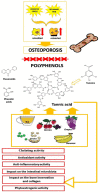The Impact of Tannic Acid Consumption on Bone Mineralization
- PMID: 37887397
- PMCID: PMC10609055
- DOI: 10.3390/metabo13101072
The Impact of Tannic Acid Consumption on Bone Mineralization
Abstract
Tannic acid (TA) is an organic compound belonging to the tannin group. Like other tannins, it has an affinity for endogenous proteins, including digestive enzymes, which can result in the reduced digestibility and absorption of nutrients. It can also form complexes with mineral components, reducing their absorption. In some cases, this can be beneficial, such as in the case of toxic metals, but sometimes it may have a detrimental effect on the body when it involves essential mineral components like Ca, P, Mg, Na, K, or Fe. Therefore, the impact of TA on bone health should be considered from both perspectives. This relatively short review summarizes the available information and research findings on TA, with a particular focus on its potential impact on bone health. It is worth noting that future research and clinical studies may provide more detailed and precise information on this topic, allowing for a better understanding of the role of TA in maintaining the integrity of the musculoskeletal system. Despite its brevity, this paper represents a valuable contribution to the analysis of the potential benefits and challenges associated with TA in the context of bone health. We anticipate that future research will continue along this important research line, expanding our knowledge of the influence of this compound on the skeletal system and its potential therapeutic applications.
Keywords: bones; osteoporosis; tannic acid.
Conflict of interest statement
The authors declare no conflict of interest.
Figures




References
-
- Vielma J.R., Picon D., Gutiérrez L.V., Lara N.D. Pathophysiology of Osteoporosis: Genes, Oxidative Stress and Immunopathogeny. A Qualitative Systematic Review. Av. Biomed. 2018;7:100–111.
-
- Xiang D., He J., Jiang T. The correlation between estrogen receptor gene polymorphism and osteoporosis in Han Chinese women. Eur. Rev. Med. Pharmacol. Sci. 2018;22:8084–8090. - PubMed
Publication types
LinkOut - more resources
Full Text Sources

